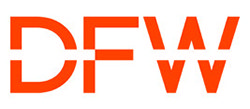Dallas Fort Worth International Airport (DFW) completed its Northeast End-Around Taxiway Project in May, making it the only U.S. airport with an end-around taxiway at both ends of a runway. The recently completed project was the last component of DFW’s three-phase Northeast End-around Taxiway Program, which started in 2018 and cost a total of $46 million.
Dallas Fort Worth International Airport (DFW) completed its Northeast End-Around Taxiway Project in May, making it the only U.S. airport with an end-around taxiway at both ends of a runway. The recently completed project was the last component of DFW’s three-phase Northeast End-around Taxiway Program, which started in 2018 and cost a total of $46 million. Designed to enhance safety and efficiency on the busy airfield, a significant portion of the program was funded by the U.S. Department of Transportation. Lisa Gahm, vice president of Operations at DFW, notes that it will also reduce aircraft taxi times, resulting in environmental benefits and increased passenger satisfaction.
 “Overall, safety is our No. 1 goal, but we also have a goal of an optimized and efficient airfield,” Gahm stresses. By July 2022, just months after the project was complete, 23,910 aircraft taxied via the northeast end-around, saving an estimated 112,316 minutes of departure delays. That, in turn, resulted in a decrease of more than 6,000 kilograms of nitrogen oxides and nearly 4.4 million kilograms of carbon dioxide. The reduction of emissions will help DFW reach its goal of being carbon neutral by 2030.
“Overall, safety is our No. 1 goal, but we also have a goal of an optimized and efficient airfield,” Gahm stresses. By July 2022, just months after the project was complete, 23,910 aircraft taxied via the northeast end-around, saving an estimated 112,316 minutes of departure delays. That, in turn, resulted in a decrease of more than 6,000 kilograms of nitrogen oxides and nearly 4.4 million kilograms of carbon dioxide. The reduction of emissions will help DFW reach its goal of being carbon neutral by 2030.
“It’s good for our airline partners, good for passengers, saves time, money and gives a better customer experience,” Gahm summarizes.
|
Project: End-Around Taxiway Location: Dallas Fort Worth Int’l Airport Cost: $46 million (all 3 phases) Funding: U.S. Dept. of Transportation Timeline: 2018-May 2022 Engineer: Jacobs Engineering Construction: Austin Bridge & Road Visual Screen: Blast Deflectors Inc. Underdrain Piping: Advanced Drainage Systems Inc. Key Benefits: Enhance airfield safety & efficiency; reduced taxi times, resulting in environmental benefits & higher passenger satisfaction |
According to FAA, end-around taxiways improve the efficiency of runway operations by providing a safe means of aircraft movement from one side of a runway to the other. They allow critical aircraft to taxi around a runway end during departure operations and cross the extended runway centerline without specific clearance from Air Traffic Control. The design of an end-around taxiway considers parameters unique to each airport and runway.
At DFW, the inboard runways, 17C and 17L, also serve as primary departure runways. This makes the airport well suited for end-around taxiways, because aircraft no longer have to wait to cross active runways. The end result is decreased operating costs for airlines, environmental benefits and increased passenger satisfaction due to reduced travel time. Airport officials estimate that taxi times are reduced by an average of four minutes as each aircraft moves from the gate to the runway or runway to gate.
What and When
As an integral part of DFW’s overall infrastructure capital plan, the recently completed end-around taxiway project included several components:
- taxiway construction and realignment,
- improvements to road for aircraft rescue and firefighting vehicles,
- asphalt shoulder construction,
- drainage improvements on the taxiway perimeter,
- a jet blast fence,
- upgraded airfield lighting and signals, and
- an end-around taxi screen.
Officials at DFW first considered an end-around taxiway in the early 1990s. At that time, they recognized that traffic would continue to increase at the growing airport, and they wanted to ensure the airfield was operating as safely and as efficiently as possible, explains Assistant Vice President of Planning Dillon Pettyjohn.
In the early 2000s, DFW constructed a southeast end-around taxiway, which quickly demonstrated benefits from an operational safety perspective. “Before the northeast end-around was in place, we saw substantial differences in the number of runway crossings as well as runway throughput from those departures when we were in south flow, which is when we were using that southeast end-around,” says Pettyjohn. “It validated what the planners had worked through and modeled.”
Complicated Undertaking
 Because of the complexities and rewards involved with a project like this, DFW wanted to sequence work in a way that not only minimized impact to operations, but also yielded benefits as soon as possible. “Phasing this into multiple construction packages was our best solution,” Pettyjohn remarks.
Because of the complexities and rewards involved with a project like this, DFW wanted to sequence work in a way that not only minimized impact to operations, but also yielded benefits as soon as possible. “Phasing this into multiple construction packages was our best solution,” Pettyjohn remarks.
Jacobs Engineering, construction contractor Austin Bridge and Road, and other key project partners collaborated on the plan, and work was divided into three phases. Planners used the phrases “inner loop” and “outer loop” in reference to the taxiway system.
Phase One concentrated work in between runways 17R and 17C. Taxiway M was extended, and, due to its interaction with 17C, it was completed while that runway was closed to minimize operational impact. Phase One also included the partial construction of Taxiway K and Taxiway EE, which was contained/fenced as landside construction to avoid impacting the airport operations area.
In addition to dividing the end-around taxiway project into three phases, planners synchronized some portions of it with the airport’s other concurrent construction. For example, crews were in the processing of rehabilitating Runway 17C-35C at the time. “We focused on building a section of that project while the runway was down because we were penetrating surfaces,” Pettyjohn explains.
A road for aircraft rescue and firefighting vehicles was realigned to remove curves and reduce response time; and the in-ground collection basin for a glycol facility was relocated about 150 feet to the east to make room for the taxiway alignment.
 Phasing for the drainage portion of the project was challenging because one of the primary requirements was to ensure the project would result in net-zero in flow-rate and velocity at each of the impacted outfalls. “We had to ensure that whatever work DFW was doing, water was released at the same flow rate or reduced flow rate,” says Al Celestain, primary designer with Jacobs. Engineers consequently specified orifice plates in the underground structures and energy dissipators at existing structures to decrease flow and velocity at the downstream outfalls. “The plates and dissipators act as a shield to reduce the flowrate and velocity at the impacted outfalls,” Celestain explains.
Phasing for the drainage portion of the project was challenging because one of the primary requirements was to ensure the project would result in net-zero in flow-rate and velocity at each of the impacted outfalls. “We had to ensure that whatever work DFW was doing, water was released at the same flow rate or reduced flow rate,” says Al Celestain, primary designer with Jacobs. Engineers consequently specified orifice plates in the underground structures and energy dissipators at existing structures to decrease flow and velocity at the downstream outfalls. “The plates and dissipators act as a shield to reduce the flowrate and velocity at the impacted outfalls,” Celestain explains.
The final phase was the outer loop and connection of Taxiway N. When it opened in April 2022, the air traffic control tower had already been using the inner loop with great success, Gahm notes. With that experience, opening the outer loop was then an easy addition, she adds. “We saw operational benefits and increased safety, and it helps support the airfield optimization and better serves our airlines and passengers.”
Gahm notes that Phase One opened incrementally, first for daytime operations and then for nighttime, to maximize the benefit of the airfield improvements. “Once the lighting and signage was complete, we were able to get it fully operational,” she adds.

Visual Barrier
A 713-foot-long, 20-foot-high visual screen from Blast Deflectors Inc. was installed to help pilots in departing aircraft visually confirm that aircraft using the new end-around taxiway are not causing a runway incursion. “This determination can easily be made due to the visual separation the uniquely designed, diagonally striped, red and white screen provides,” explains Matt Anzai, sales manager at Blast Deflectors. The company was contracted to design and supply a visual screen to Austin Bridge and Road in April 2019.
Airport Design AC 150/5300-13B details requirements for end-around taxiway visual screens, which partially or completely mask aircraft using the end-around taxiway from the vantage point of the associated runway. “That prevents the pilot from thinking an aircraft is crossing the runway while they are departing,” Pettyjohn explains.
 Anzai notes that the size of an end-around taxi screen depends on runway geometry and the size of the critical aircraft design group operating at a given airport, all outlined in FAA AC 150/5300-13B. “FAA design equations were used, which incorporate specific factors, including aircraft type, surface grade, the height of the pilot’s eye at V1, engine nacelle height, etc.,” he adds.
Anzai notes that the size of an end-around taxi screen depends on runway geometry and the size of the critical aircraft design group operating at a given airport, all outlined in FAA AC 150/5300-13B. “FAA design equations were used, which incorporate specific factors, including aircraft type, surface grade, the height of the pilot’s eye at V1, engine nacelle height, etc.,” he adds.
At DFW, the end-around taxi screen is located beyond the end of the runway. The structure includes frangible elements, such as multiple breakaway connections in specific areas that are designed to strategically break apart in the event of an incursion.
Partnerships Prove Valuable
Gahm says that the partnership with FAA cannot be understated regarding the success of this project and the team’s ability to overcome challenges. Any airfield project will impact air traffic controllers, and it’s important to have cooperation and understanding from the beginning, she adds.
Like most projects that occurred in 2020 and 2021, the construction schedule for DFW’s new end-around taxiway benefited from reduced operations due to COVID-19. On the flip side, the project team encountered employee shortages and supply chain issues. Heavy rainfall and other inclement weather also presented challenges.
In addition to supply chain delays, price increases and product availability affected the project. With construction already in motion, Austin Bridge and Road experienced difficulties procuring underdrain materials. It consequently requested and received approval from the engineer to use alternate materials that met the required performance criteria.
 Engineers chose dual-wall high-density polyethylene pipe from Advanced Drainage Systems Inc. to be used for more than 12,000 feet of underdrain along the proposed taxiway. “The critical underdrain will ensure that both groundwater and runoff are moved quickly from the taxiway,” says Joshua Herchl, director of municipal markets for Advanced Drainage Systems Inc.
Engineers chose dual-wall high-density polyethylene pipe from Advanced Drainage Systems Inc. to be used for more than 12,000 feet of underdrain along the proposed taxiway. “The critical underdrain will ensure that both groundwater and runoff are moved quickly from the taxiway,” says Joshua Herchl, director of municipal markets for Advanced Drainage Systems Inc.
The company was able to ship the needed materials from two of its plants in Texas, allowing the project to stay on time and within budget, adds Herchl.
Celestain notes that the entire project team was flexible and worked together to keep the project moving forward. Cooperation was particularly important when crews encountered unmarked, underground utilities. “Everyone worked in concert to make in-the-field decisions,” he remarks. “Between DFW, stakeholders, Operations, project management and construction management teams, we all worked really well at making it come to life.”
Encouraged by the success of the new end-around taxiway and its predeccessor, DFW is currently finishing the design and preparing to begin construction of another on the southwest side of the airport. “It showcases our commitment to continued safety and efficiency,” Pettyjohn says.


 facts&figures
facts&figures

